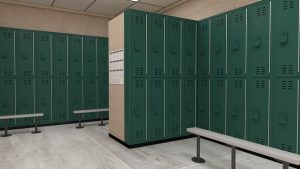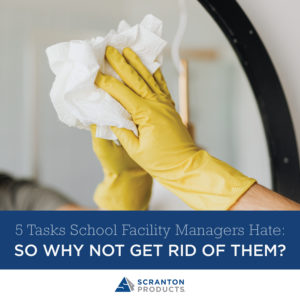As popular designs and trends are on the rise within specific industries, there’s one area that needs more attention than ever before. There is simply no better time to renovate run-down or outdated areas in public facilities. Two specific areas are locker rooms and restrooms. In 2023 and beyond, it’s more important than ever to provide a safe, private, modern, and inclusive design to your facility’s locker room or restroom.
So, when you’re thinking about what design trends to run with, what exactly are the biggest and most important reasons to update restrooms or lockers? Some may simply need to replace rusted lockers for better eye-appeal or safety concern since someone could get cut, others may need to take care of more challenging requests like plumbing issues creating damp environments which lead to rust and corrosion within the area. Or, some may want to upgrade for the benefit of a successful sports program to commemorate their home team. Whichever your reason for revamping your lockers or restroom partitions, it’s important for facility managers to keep in mind that these areas are more than just places to change, shower, and serve as functional public necessities—they can, in fact, complement your facility’s overall design scheme.
In this blog, we’ll discuss current design trends and what is working for the locker room and restroom partition industry based on a few factors of what’s been tried and true and rising in popularity with today’s society. Keeping these trends in mind will help your facility reap the benefits of HDPE plastic with Scranton Products brands.
Designed for Modernness & Privacy
Just because you’re looking for privacy doesn’t mean you have to forfeit a modern, sleek design that compliments the style of your restroom or locker room. Today, style and privacy go hand-in-hand, and everyone wants to feel comfortable in a private setting such as restrooms or locker rooms.
Scranton Products® Aria Partitions® are our full height partition and were developed to add enhanced comfort and privacy to your restroom design. Aria Partitions aesthetics combined with its solid HDPE material gives you a restroom design , and customizable to fit your project’s desired level of privacy and design.
Locker rooms are places that have a bad reputation because we often associate them with loud, slamming, rusty lockers from storing damp or sweaty items in. No matter what storage needs your facility has, Tufftec Lockers® have a solution. With a multitude of styles, configurations, and interchangeable options, you can create customized lockers that make the most of a space, while still giving you design options that complement your building in a durable HDPE material.
Restroom Partitions are Gender Inclusive
Co-ed dorms are on the rise, including gender-inclusive bathrooms in public facilities such as colleges and universities, now more than ever. Low privacy bathroom designs are a thing of the past! Instead, choose high-privacy restroom partitions that reduce sightlines and boastfully enclosed compartments that are not only attractive but also gender-neutral friendly.
We aren’t just talking about dorms and restroom facilities in high traffic areas, some students did not feel safe nor comfortable in their campus recreational facilities locker rooms because they were outdated, and not giving as much privacy as they would like. It’s important for these high-traffic facilities to accommodate the needs of others to feel safe and secure in a locker room or restroom that is meant for changing and private purposes.
Aesthetically Pleasing Designs
An attractive, sophisticated restroom partition or locker can make all the difference when it comes to the appearance of a commercial restroom or locker room. In fact, many facilities opt for slightly more expensive materials for their counters in order to create this quality look.
But did you know that higher quality materials, such as high-density polyethylene (HDPE) plastic, are often nonporous which means they’ll stay cleaner since HDPE is naturally germ resistant? This type of material may be slightly more expensive at the initial purchase, but the costs you’ll save in maintenance over the years making it less expensive in the long run.
When it comes to locker design, Scranton Products creates lockers and restrooms for strength and durability, all while keeping a modern, clean, and sophisticated design. The major difference between metal and HDPE lockers and partitions is the impact resistant properties that HDPE plastic holds. These products are also resistant to mold and bacteria, have low maintenance costs due to being power washable and steam cleanable, and offer the ability to choose from an array of styles for a custom locker or partition that matches your brand.
Sustainable Products
More and more companies are considering the carbon footprint they’re leaving and choosing sustainable products that are less harmful to the environment and better for the people in the facility. Some products give off emissions that reduce the quality of the air and can end up diminishing health.
Not only is HDPE plastic customizable, impact and moisture resistant, power-washable, easy to maintain, but Scranton Products® HDPE plastic also provides an extensive collection of colors and textures to choose from for your next restroom or locker room project.
When we are talking about restroom partitions, opting to choose plastic shoes and brackets increases the overall sustainability of your system by allowing the recycling process to become more streamlined at end-of-use, allowing for easier disposal. Not only do they both retain the same benefits offered by solid plastic materials, but they can be recycled all at once instead of being separated.
HDPE plastic can be made from recycled material and helps improve the air quality. This is especially helpful for restrooms and locker rooms that are heavily used, and are very easy to clean, and of course will never rust. And because HDPE plastic is solid color throughout, it never requires paint, so VOC emissions are avoided.
Focusing on Student Athletes
It’s to no surprise that school sports are a major part of a lot of students’ lives. Where the sport starts and ends is often in a Scranton Products Tufftec Lockers are engravable so you can show your school pride with your mascot or team logo, too!
What’s even more important with branding and mascot is recruiting visits for potential future players that are going to be representing the team and school. A cohesive design throughout a locker room is necessary in order to establish team-wide communication for those specific mascot and colors for the team’s history, community, and culture.
Hopefully now you have a better understanding of today’s current design trends for restroom partitions and lockers. It’s a given that we are focused on sustainability and privacy options now more than ever and it’s up to us to implement these needs into current design trends.






